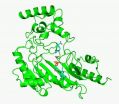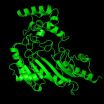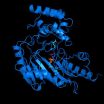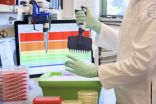Researchers bring to life proteins' motion
OHSU study fills decades-long gap in knowledge
2015-06-18
(Press-News.org) PORTLAND, Ore. -- Advancing the field of structural biology that underpins how things work in a cell, researchers have identified how proteins change their shape when performing specific functions. The study's fresh insights, published online in the journal Structure, provide a more complete picture of how proteins move, laying a foundation of understanding that will help determine the molecular causes of human disease and the development of more potent drug treatments.
Though it has long been recognized that proteins are not static, for more than 30 years, scientists' understanding of proteins was limited to observing their structure through static snapshots taken using crystallography, a technique used to capture images of molecules' structures in various configurations.
In order to understand proteins' normal functioning, and design treatments for when cells malfunction, scientists needed, but lacked, a dynamic picture of proteins' coordinated motions. The one experimental technique through which scientists could observe motion, nuclear magnetic resonance (NMR) spectroscopy, has been used with fewer than 1 percent of proteins because the majority of proteins are too large, complex, difficult to obtain or not soluble.
To fill the gap in knowledge, the researchers designed a computer method that looked at two different snapshots of the same protein structures, captured through crystallography, and identified hinge points, or 'hot spots,' of flexibility. In doing so, the researchers successfully affirmed the premise that proteins use the ranges of motion that are most efficient. Through improved understanding of the mechanics of motion, researchers will be better able to analyze the changes in proteins as they interact with other molecules, regulating how cells function.
'For more than 30 years, the biology textbooks of medical students have contained static pictures of the structures of more than 100,000 proteins. This study is a step toward bringing those snapshots to life by understanding the motions that are involved in how proteins catalyze reactions or regulate biological processes,' said Michael Chapman, Ph.D., professor of biochemistry and molecular biology, OHSU School of Medicine, and member of the Knight Cancer Institute. 'By way of analogy, a snapshot of a thoroughbred horse doesn't tell you much about how it's running. This paper is a step toward learning how proteins are moving to go about their business.'
INFORMATION:
Researchers who contributed to the study, 'Parsimony in Protein Conformational Change,' include Chapman; Brynmor K. Chapman, previously with OHSU, currently with Computer Science Department at Stanford University; Omar Davulcu, OHSU; Jack J. Skalicky, Department of Biochemistry, University of Utah; and Rafael P. Brueschweiler, Department of Chemistry & Biochemistry, Ohio State University.
About OHSU
Oregon Health & Science University is a nationally prominent research university and Oregon's only public academic health center. It serves patients throughout the region with a Level 1 trauma center and nationally recognized Doernbecher Children's Hospital. OHSU operates dental, medical, nursing and pharmacy schools that rank high both in research funding and in meeting the university's social mission. OHSU's Knight Cancer Institute helped pioneer personalized medicine through a discovery that identified how to shut down cells that enable cancer to grow without harming healthy ones. OHSU Brain Institute scientists are nationally recognized for discoveries that have led to a better understanding of Alzheimer's disease and new treatments for Parkinson's disease, multiple sclerosis and stroke. OHSU's Casey Eye Institute is a global leader in ophthalmic imaging, and in clinical trials related to eye disease.
ELSE PRESS RELEASES FROM THIS DATE:
2015-06-18
The secret to preventing HIV infection lies within the human immune system, but the more-than-25-year search has so far failed to yield a vaccine capable of training the body to neutralize the ever-changing virus. New research from The Rockefeller University, and collaborating institutions, suggests no single shot will ever do the trick. Instead, the scientists find, a sequence of immunizations might be the most promising route to an HIV vaccine.
Scientists have thought for some time that multiple immunizations, each tailored to specific stages of the immune response, ...
2015-06-18
BOSTON, June 18 -- An analysis of five families has revealed a previously unknown genetic immunodeficiency, says an international team led by researchers from Boston Children's Hospital. The condition, linked to mutations in a gene called DOCK2, deactivates many features of the immune system and leaves affected children open to a unique pattern of aggressive, potentially fatal infections early in life.
As the researchers -- led by Kerry Dobbs and Luigi Notarangelo, M.D., of Boston Children's Division of Allergy and Immunology -- reported today in the New England Journal ...
2015-06-18
Musicians don't just hear in tune, they also see in tune.
That is the conclusion of the latest scientific experiment designed to puzzle out how the brain creates an apparently seamless view of the external world based on the information it receives from the eyes.
"Our brain is remarkably efficient at putting us in touch with objects and events in our visual environment, indeed so good that the process seems automatic and effortless. In fact, the brain is continually operating like a clever detective, using clues to figure out what in the world we are looking at. And ...
2015-06-18
A trio of studies being published today in the journals Science and Cell describes advances toward the development of an HIV vaccine. The three study teams all demonstrated techniques for stimulating animal cells to produce antibodies that either could stop HIV from infecting human cells in the laboratory or had the potential to evolve into such antibodies. Each of the research teams received funding from the National Institute of Allergy and Infectious Diseases (NIAID), part of the National Institutes of Health.
In one study, published in Science, researchers demonstrate ...
2015-06-18
CHAPEL HILL, NC - Before there were cells on Earth, simple, tiny catalysts most likely evolved the ability to speed up and synchronize the chemical reactions necessary for life to rise from the primordial soup. But what those catalysts were, how they appeared at the same time, and how they evolved into the two modern superfamilies of enzymes that translate our genetic code have not been understood.
In the Journal of Biological Chemistry, scientists from the UNC School of Medicine provide the first direct experimental evidence for how primordial proteins developed the ...
2015-06-18
Parkinson disease (PD) appeared associated with 16 types of cancer in a study in Taiwan, an effort to explain the association in an East Asian population because most prior research has been conducted in Western populations, according to an article published online by JAMA Oncology.
During the past 50 years, more than 25 epidemiological studies have been conducted on the association between PD and cancer, and most of those studies showed that individuals with PD had a decreased risk of cancer compared to those without PD. However, most of those studies were done in Western ...
2015-06-18
A survey carried out earlier this year has found the first evidence of the 'superbug' bacteria Methicillin-Resistant Staphylococcus aureus (MRSA) in sausages and minced pork obtained from supermarkets in the UK. However, researchers stress that this does not pose a significant immediate risk to the public.
In February, a team of researchers funded primarily by the Medical Research Council (MRC) bought and analysed a total of 103 (52 pork and 51 chicken) pre-packaged fresh meat products, labelled as being of UK farm origin, from supermarkets in five different locations ...
2015-06-18
PITTSBURGH, June 17 -- Regardless of chronological age, people who live in neighborhoods with high crime, noise and vandalism are biologically more than a decade older than those who do not, according to a study led by researchers from the University of Pittsburgh. The findings were published online today in PLOS One.
Strong research evidence supports that living in disadvantaged neighborhoods has an unfavorable impact on mental and physical health, explained lead author Mijung Park, Ph.D., M.P.H., R.N., assistant professor, University of Pittsburgh School of Nursing. ...
2015-06-18
High in the sky where the cirrus ice crystal clouds form, jet contrails draw their crisscross patterns. Now researchers have found that these elevated ice cloud trails can influence temperatures on the ground and affect local climate, according to a team of Penn State geographers.
"Research done regarding September 2001, during the three days following 9-11 when no commercial jets were in the sky, suggested that contrails had an effect," said Andrew M. Carleton, professor of geography. "But that was only three days. We needed to look longer, while jets were in the air, ...
2015-06-18
Scientists at UCL have observed how a widespread polar wind is driving gas from the atmosphere of Saturn's moon Titan. The team analysed data gathered over seven years by the international Cassini probe, and found that the interactions between Titan's atmosphere, and the solar magnetic field and radiation, create a wind of hydrocarbons and nitriles being blown away from its polar regions into space. This is very similar to the wind observed coming from the Earth's polar regions.
Titan is a remarkable object in the Solar System. Like Earth and Venus, and unlike any other ...
LAST 30 PRESS RELEASES:
[Press-News.org] Researchers bring to life proteins' motion
OHSU study fills decades-long gap in knowledge






